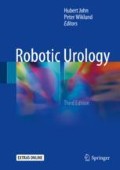Abstract
When treating localised prostate cancer, excellent oncological outcomes with low rate of complications are nowadays possible with radical prostatectomy (RP) (Bill-Axelson et al., N Engl J Med 364:1708–1717, 2011; Novara et al., Eur Urol 62:382–404, 2012). However, functional outcomes in terms of continence and potency recovery are still less enthusiastic. Indeed, in patients who do not early recover continence quality of everyday life is markedly reduced, especially in younger and more active ones (Sanda et al., N Engl J Med 358:1250–1261, 2008). The proportion of continent patients at one year after surgery ranges from 70% to 100% in the available Literature (Fig. 34.1) (Ficarra et al., Eur Urol 62:405–417, 2012). Such disparities in the literature are probably due to either non-homogeneous definition of continence or measurement methods (questionnaires, number of pads, pad test). Several factors have been identified as leading to, including patient characteristics (body mass index, age, prostate volume, and comorbidities), experience of the surgeon, and surgical precision (Ahlering et al., Curr Urol Rep 14:52–58, 2013).

Prospective and retrospective studies comparing different robot-assisted radical prostatectomy surgical techniques. From the Systematic review and meta-analysis of studies reporting urinary continence recovery after robot-assisted radical prostatectomy by Ficarra et al. Eur Urol. 2012;62:405–17
References
Bill-Axelson A, Holmberg L, Ruutu M, et al. Radical prostatectomy versus watchful waiting in early prostate cancer. N Engl J Med. 2011;364:1708–17.
Novara G, Ficarra V, Mocellin S, et al. Systematic review and metaanalysis of studies reporting oncologic outcome after robot-assisted radical prostatectomy. Eur Urol. 2012;62:382–404.
Sanda MG, Dunn RL, Michalski J, et al. Quality of life and satisfaction with outcome among prostate-cancer survivors. N Engl J Med. 2008;358:1250–61.
Ficarra V, Novara G, Rosen RC, et al. Systematic review and metaanalysis of studies reporting urinary continence recovery after robot-assisted radical prostatectomy. Eur Urol. 2012;62:405–17.
Ahlering TE, Gordon A, Morales B, Skarecky DW. Preserving continence during robotic prostatectomy. Curr Urol Rep. 2013;14:52–8.
Wang W, Huang QM, Liu FP, Mao QQ. Effectiveness of preoperative pelvic floor muscle training for urinary incontinence after radical prostatectomy: a meta-analysis. BMC Urol. 2014;14:99.
Ficarra V, Novara G, Artibani W, et al. Retropubic, laparoscopic, and robot-assisted radical prostatectomy: a systematic review and cumulative analysis of comparative studies. Eur Urol. 2009;55:1037–63.
Porpiglia F, Bertolo R, Manfredi M, et al. Total anatomical reconstruction during robot-assisted radical prostatectomy: implications on early recovery of urinary continence. Eur Urol. 2016;69:485–95.
Galfano A, Di Trapani D, Sozzi F, Strada E, Petralia G, Bramerio M, Ascione A, Gambacorta M, Bocciardi AM. Beyond the learning curve of the Retzius-sparing approach for robot-assisted laparoscopic radical prostatectomy: oncologic and functional results of the first 200 patients with ≥ 1 year of follow-up. Eur Urol. 2013;64(6):974–80.
Vora AA, Dajani D, Lynch JH, Kowalczyk KJ. Anatomic and technical considerations for optimizing recovery of urinary function during robotic-assisted radical prostatectomy. Curr Opin Urol. 2013;23:78–87.
Gratzke C, Dovey Z, Novara G, et al. Early catheter removal after robot-assisted radical prostatectomy: surgical technique and outcomes for the Aalst technique (ECaRemA study). Eur Urol. 2016;69:917–23.
Ficarra V, Wiklund PN, Rochat CH, et al. The European Association of Urology Robotic Urology Section (ERUS) survey of robot-assisted radical prostatectomy (RARP). BJU Int. 2013;111(4):596–603.
Patel VR, Coelho RF, Palmer KJ, et al. Periurethral suspension stitch during robot-assisted laparoscopic radical prostatectomy: description of the technique and continence outcomes. Eur Urol. 2009;56:472–8.
Tewari A, Jhaveri J, Rao S, et al. Total reconstruction of the vesicourethral junction. BJU Int. 2008;101:871–7.
Kojima Y, Takahashi N, Haga N, et al. Urinary incontinence after robot-assisted radical prostatectomy: pathophysiology and intraoperative techniques to improve surgical outcome. Int J Urol. 2013;20(11):1052–63.
Tewari AK, Bigelow K, Rao S, et al. Anatomic restoration technique of continence mechanism and preservation of puboprostatic collar: a novel modification to achieve early urinary continence in men undergoing robotic prostatectomy. Urology. 2007;69:726–31.
Sugimura Y, Hioki T, Yamada Y, Fumino M, Inoue T. An anterior urethral stitch improves urinary incontinence following radical prostatectomy. Int J Urol. 2001;8:153–7.
Noguchi M, Noda S, Nakashima O, Matsuoka K, Kojiro M. Suspension technique improves rapid recovery of urinary continence following radical retropubic prostatectomy. Kurume Med J. 2004;51:245–51.
Patel VR, Thaly R, Shah K. Robotic radical prostatectomy: outcomes of 500 cases. BJU Int. 2007;99:1109–12.
Rocco B, Gregori A, Stener S, et al. Posterior reconstruction of the rhabdosphincter allows a rapid recovery of continence after transperitoneal videolaparoscopic radical prostatectomy. Eur Urol. 2007;51:996–1003.
Rocco F, Carmignani L, Acquati P, et al. Restoration of posterior aspect of rhabdosphincter shortens continence time after radical retropubic prostatectomy. J Urol. 2006;175:2201–6.
Moinzadeh A, Shunaigat AN, Libertino JA. Urinary incontinence after radical retropubic prostatectomy: the outcome of a surgical technique. BJU Int. 2003;92:355–9.
Takenaka A, Tewari AK, Leung RA, et al. Preservation of the puboprostatic collar and puboperineoplasty for early recovery of urinary incontinence after robotic prostatectomy: anatomic basis and preliminary outcomes. Eur Urol. 2007;51:433–40.
Menon M, Muhletaler F, Campos M, Peabody JO. Assessment of early continence after reconstruction of the periprostatic tissues in patients undergoing computer assisted (robotic) prostatectomy: results of a 2 group parallel randomized controlled trial. J Urol. 2008;180:1018–23.
Author information
Authors and Affiliations
Corresponding author
Editor information
Editors and Affiliations
Rights and permissions
Copyright information
© 2018 Springer International Publishing AG
About this chapter
Cite this chapter
Porpiglia, F., Bertolo, R., Fiori, C. (2018). Anterior Reconstruction After Radical Prostatectomy. In: John, H., Wiklund, P. (eds) Robotic Urology. Springer, Cham. https://doi.org/10.1007/978-3-319-65864-3_34
Download citation
DOI: https://doi.org/10.1007/978-3-319-65864-3_34
Published:
Publisher Name: Springer, Cham
Print ISBN: 978-3-319-65863-6
Online ISBN: 978-3-319-65864-3
eBook Packages: MedicineMedicine (R0)

